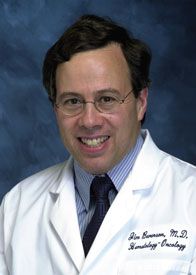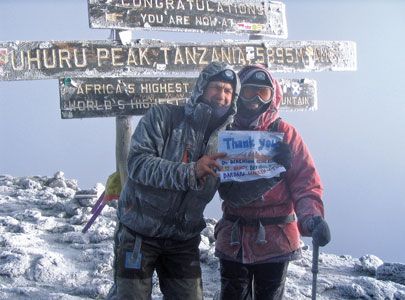Climbing to New Heights: James Berenson, MD, and the Institute for Myeloma and Bone Cancer Research
Oncologist James Berenson, MD, likes all of his patients, especially the ones with whom he skis.

James Berenson, MD
Oncologist James Berenson, MD, likes all of his patients, especially the ones with whom he skis.
The treatment rooms in Berenson’s West Hollywood, California clinic, where he treats hundreds of multiple myeloma patients, are named after famous slopes in the western United States. “When I am examining a patient, I imagine I am skiing a mountain,” Berenson says.
Berenson was skiing with a patient, investment adviser Geoffrey Wainwright, in Utah when he took a spill and fell on his head. As Wainwright’s wife, an orthopedic surgeon, stood over him, the 58-year-old oncologist couldn’t help cracking a doctor joke.
“OK,” Berenson announced, “I get a free consult.”
A free consult might be a kind gesture of gratitude to the oncologist, but a year later the Wainwrights would show another sign of appreciation. A multiple myeloma patient of 4 years at the time, yet still an avid mountain climber, Wainwright overcame frostbite, howling zero-degree winds, and thin air to climb atop Mount Kilimanjaro’s 19,340-foot summit, the world’s tallest freestanding mountain. Once at the summit, Wainwright and his wife held up a sign that read, “Thank you, Dr Berenson.”
A photo of that triumphal moment hangs in Berenson’s office. Now at the 4½-year mark and planning more mountain climbs and some sprint triathlons, the energetic Wainwright says he can’t help thinking of Kilimanjaro without also thinking of his doctor.

Sunset Medical Tower, home of the Institute for Myeloma and Bone Cancer Research.
“I don’t think I would be alive today if it weren’t for Jim,” Wainwright said. “Four years ago, I didn’t know I would still be alive. Here I feel great doing all the things I wanted to do and wouldn’t have imagined I could do. Even training for Kilimanjaro was a daunting task, and Dr Berenson, to his credit, was never one of those doctors who said I couldn’t do it.”
Berenson’s work at the Institute for Myeloma and Bone Cancer Research, where he serves as the medical and scientific director and chief executive officer of Oncotherapeutics, may be keeping many myeloma patients like Climbing to New Heights James Berenson, MD, and the Institute for Myeloma and Bone Cancer Research Wainwright alive, and for years longer than they expect.
And their quality of life has risen dramatically as well, Berenson said. The reasons, his patients and fellow doctors say, involve a three-pronged approach.
“He has a first-class laboratory doing research, a clinic where he does treatment with his patients, and then he does the fundraising. It is unique with a capital U,” said Anne Meyer, MD, a physical medicine rehabilitation and pain management specialist who treats Berenson’s patients. “When he has the fundraisers, his patients love to be there and give back. It’s a sign that they’re so connected to him and his mission that they want to give back. They don’t forget him.”
Berenson is proud of his Institute, its staff, and its capabilities. “The only thing we send out for is radiation and surgery. We have a mini-university,” he said.
The Institute is also, Berenson added wryly, “a three-ring circus.”
"...The bigger the institution, the more you can blame it on everybody else. That doesn’t happen here. Here we are all responsible.”
—James Berenson, MD
Berenson, said patient Jackie Rabinowitz, is the ringmaster. A 47-year-old therapist with multiple myeloma, Rabinowitz was diagnosed about 2 years ago and went to the Institute almost immediately.
“Pretty much everyone I spoke with said he was the way to go, that he was a cutting-edge, out-of-the box thinker, leading the field with his research. I liked that because what I had read online about multiple myeloma seemed a little bit daunting,” Rabinowitz said.
According to American Cancer Society statistics released in April 2010, the lifetime risk of contracting multiple myeloma is 1 in 159 in the United States. About 20,180 new cases will be diagnosed (11,170 in men and 9,010 in women) annually.1
The 5-year relative survival rate for multiple myeloma is around 35%, with younger people more likely to live longer. However, the statistics indicate that recent improvements in treatment may result in a more favorable outlook for recently diagnosed patients, with, in some cases, the cancer going into remission for a time.2
Wainwright learned he had the disease after wakeboarding for the first time with friends in Utah, when on his first routine fall into the water, he broke his left shoulder—a possible indication that his bones were brittle. He and his wife were stunned to discover that he had multiple myeloma.
“I walked into his clinic having read on the Internet that I might have three years to live,” Wainwright said. “To think your life will be cut that short is just incredibly depressing.”
The first thing Berenson did that impressed them, Wainwright and Rabinowitz said, was give them his personal cell phone number, with instructions to call whenever they needed to. Berenson said he does that with all of his patients.
“The reassurance of knowing that I can contact him anytime takes one whole layer of stress away. It might not sound like a big thing, but it’s huge when you are dealing with a complicated disease,” Rabinowitz said. “He is the only doctor I know who does it.”
Berenson listens to his patients, according to Meyer. “He will call me two or more times a week and refer patients to me, and what’s cool about him is that he knows everything about them medically, and he will give me a little pearl about them as a person.”
"Even training for Kilimanjaro was a daunting task, and Dr Berenson, to his credit, was never one of those doctors who said I couldn’t do it.”
—Geoffrey Wainwright

Wainwright finds that going to a clinic that treats only myeloma patients gives the place a warmer, more sympathetic feel. Patients don’t have to explain themselves or their illness. Everyone understands their problems already, and among staff, everyone is helpful, he said.
“The objective here is to take care of the patient,” said Berenson. “When you go to larger institutions, things get in the way. There’s a diffusion of responsibility. The bigger the institution, the more you can blame it on everybody else. That doesn’t happen here. Here we are all responsible.”
Under Berenson’s approach, the research and treatment wings of the Institute work together on a patient’s care, said Laura Audell, MD, an internist and anesthesiologist who has known Berenson since 1984. Berenson doesn’t just treat cancer. “By aggressively investigating myeloma’s side effects and developing treatments for them, he helps keep his patients alive longer and maintain their quality of life, while he gains insight into the workings of the disease,” said Audell.
His approach to each patient, she said, is open-minded enough to include modalities such as acupuncture, physical therapy, and nutritional evaluations, but comprehensive enough to match treatments to patients’ lifestyles. He also works with the Institute’s researchers to investigate input from patients that might help create more and better ways to treat the disease, she said.
“He has the ability to be an expert on both sides of the coin, so he has a lot of ideas that he develops in the laboratory that he brings to the clinic,” said Marshall Flam, MD, a Fresno-based oncologist and hematologist whose practice handles about 300 cases a week.
Berenson’s somewhat offbeat approach might be why he generally prescribes lower doses of antimyeloma drugs, with less toxicity and side effects for patients, and why he is also known for avoiding bone marrow transplant operations, which don’t have a proven success rate with multiple myeloma, said Flam.
“In the university [research setting], you get disconnected from the patient. I don’t get disconnected from the patient,” Berenson said. “The beauty of this setup is I can do things both ways.”
Audell said that Berenson was among the first doctors she saw employing kyphoplasty, the use of acrylic cement to stabilize and reduce pain associated with vertebral compression fractures and restore vertebral height. Spinal fracture is a common side effect in myeloma patients.
Dr James Berenson Talks About Arsenic Trioxide
Most recently, Berenson said he has been using arsenic trioxide to break down proteins that drive myeloma and make it resistant to treatment, and inhibit the growth of blood vessels that help myeloma to grow, though the treatment is not yet FDA-approved.3 Berenson can legally use it, he said, with patient permission on patients for whom all other multiple myeloma treatment options have been exhausted.
Berenson also mixes his investigative treatments with FDA-approved treatments that are tried and true. He uses bisphosphonates, drugs that have been used for years to slow or stop the dissolving of bone tissue. “We use bisphosphonates on all of our patients.”
“I have spoken to patients at the clinic whose previous oncologists had said, ‘We have nothing more we can do for you. Go home,’” Rabinowitz said. “Dr Berenson will keep trying to find combinations that work,” she added. “He is a scientist, and to me a good scientist is a detective. Dr Berenson is a detective. He is interested in finding out, in looking. He is passionate about it. He is not just interested in administering drugs.”
Anyone seeking a doctor to treat cancer should look for that quality, Wainwright said. Extensive experience with, and a strong awareness of, all of the newest treatments for the disease is important, as is an ability to recognize a patient’s humanity.
“I would look for someone that I felt I could be very comfortable being very open and honest with and have that kind of rapport with,” Wainwright said. “You will be spending a lot of time with this person, so you want to feel like it’s someone you can truly view as a friend.
"The eye on the ball today is the dollar bill. It’s a major problem. We forget that we are supposed to keep an eye on the patient. We need to care about patients, not dollar bills.”
—James Berenson, MD
“It’s not always going to be good news. What is impressive to me about Dr Berenson is that as busy as he is, if there is bad news in a test, he will call up ahead of the appointment and tell you so you can be better prepared,” Wainwright added. “With him, you can be mentally prepared for the bad news, maybe do your own research, and discuss the bad news with your spouse so you are not getting hit cold with the bad news as you walk in the door.”
And Geoffrey Gee, chief operating officer of James R. Berenson, MD, Inc, which is Berenson’s medical practice, said that Berenson consults with hundreds of doctors and patients worldwide about multiple myeloma, and helps doctors to shape patient treatment. Berenson said his approach is fueled by experience, as well as a disgust for bureaucracy and the facile trends of medicine.
“I have worked in many settings, and they all have their problems,” Berenson said. “If you are in private care, the objective is to do as many tests as you can. If you are in an HMO setting, the objective is to do nothing because you get penalized for giving tests. Concierge medicine represents a lot of hand-holding by people who really, in my view, are not the crème de la crème of the medical profession.
“The eye on the ball today is the dollar bill. It’s a major problem. We forget that we are supposed to keep an eye on the patient,” he added. “We need to care about patients, not dollar bills.”
References
- American Cancer Society. Multiple myeloma overview and detailed guide. Available at: Multiple Myeloma Key Statistics. Accessed January 19, 2011.
- American Cancer Society. Multiple myeloma overview and detailed guide. Available at: Multiple Myeloma After Follow-Up. Accessed January 19, 2011.
- Video presentation on arsenic as a cancer treatment by Dr. James Berenson. Available at: Dr. James Berenson on Treating Multiple Myeloma with Arsenic, and Doctor Talks About Arsenic Trioxide. Accessed January 19, 2011.
Berenson believes that while medicine has a long way to go before multiple myeloma will be cured, more patients are living longer than ever before, and multiple myeloma and other cancers that affect the bones will be cured.
“Myeloma today is a marathon, not a sprint race,” he said, “and eventually, we’re going to win.”
And whenever he needs inspiration, Berenson looks at the picture of his friend Geoff Wainwright standing atop Kilimanjaro with notions of other peaks to climb.
“It inspires me,” Berenson said, “that this guy gets to have a complete life now. It’s pretty cool.”
"Five More Years"

The Institute for Myeloma and Bone Cancer Research is working with the director and producers of “Five More Years.” Berenson (left) has been advising the movie’s main players, such as Sugar Ray Leonard (right), on technical issues regarding multiple myeloma.
Marcie Aboulafia is nothing if not a fighter, and her good friends, screenwriters Bruce Reisman and Kris Black, have had a ringside seat to her battle against multiple myeloma for years. Aboulafia’s story is the inspiration for “Five More Years,” a $4.5-million independent movie scheduled to be shot in Detroit this spring with an eye toward a premiere at the 2011 Cannes Film Festival.
Black will star as Alex Winston, a West Virginia coal miner and amateur boxer who turns pro when his mother is diagnosed with multiple myeloma, and Reisman will direct the picture, which is being produced by Four-Legged Pictures in the production company’s debut film.
The disease is a thread running through storylines in front of and behind the camera, as former lightweight boxing champion Sugar Ray Leonard, whose father battled multiple myeloma, is costarring as an ex-fighter, boxing trainer, and promoter who takes on Alex after a TV news reporter covers his story.
Sugar Ray, the legendary real-life victor over Roberto Duran, is also training Black for the fight scenes in the film, coproducing the movie, and arranging for some big-name boxers to participate in the fight sequences.
“Rocky” Oscar-winning film editor Scott Conrad will edit the movie, and Jackie Kallan, the “First Lady of Boxing” who has already been portrayed by Meg Ryan in the film “Against the Ropes,” gave the film her blessing and helped lure Leonard into the project.
The film is due for a fall 2011 release in time to qualify for this year’s Academy Awards.




